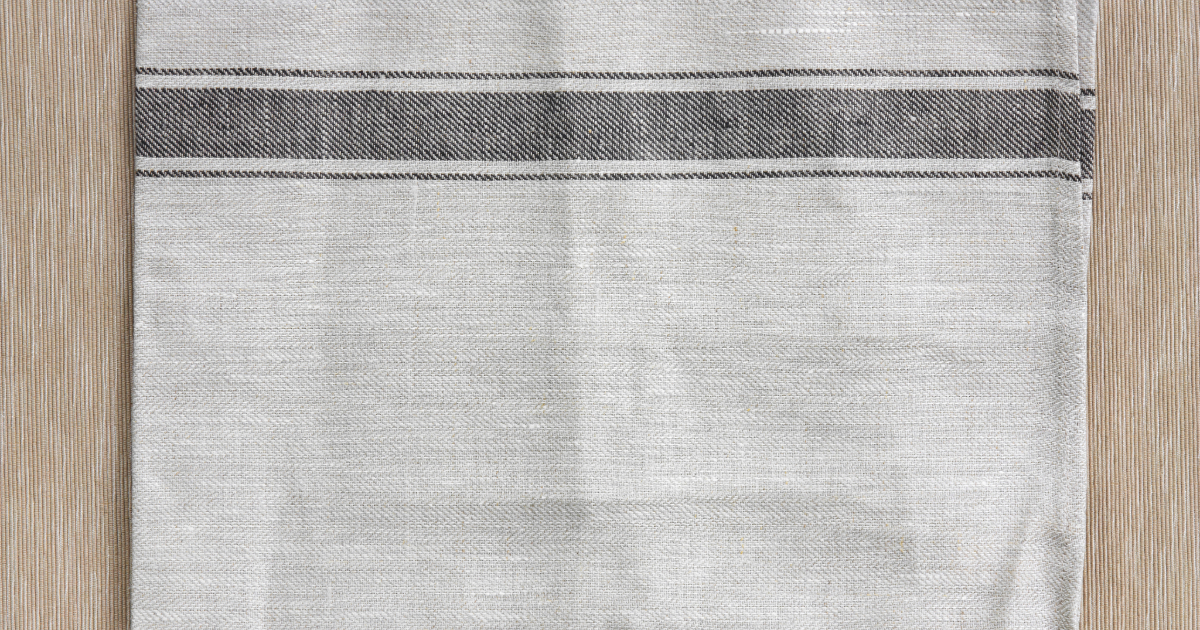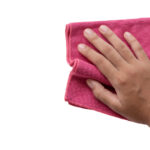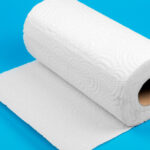A dish towel, sometimes called a tea towel, is an essential item found in most kitchens.

But what exactly is a dish towel and how is it different from other types of towels?
What is a Dish Towel Made Of?
Dish towels are almost always made from terry cloth, which is made of cotton. Terry cloth consists of loops of cotton threads that create a very absorbent and relatively thick fabric perfect for soaking up water and drying dishes.
Other materials dish towels may be made from include:
Most standard and inexpensive dish towels found in grocery and big box stores will be made of 100% cotton terry cloth or a cotton/polyester blend. Higher end dish towels from specialty stores may contain linen, microfiber blends, or bamboo.
Key Takeaway: Dish towels are almost always made from very absorbent terry cloth cotton, though they may also contain linen, microfiber, bamboo, or other highly absorbent materials.
Absorbency and Durability
Two of the most important characteristics of a high quality dish towel are absorbency and durability. The whole point of a dish towel is to quickly soak up water and liquid to dry dishes, hands, counters and more.
Terry cloth cotton is ideal for this purpose as the piled loops can hold a large volume of water. However, cheaper cotton that is too thin may soak through easily and not be as useful for drying. Make sure to select a towel made from tightly woven quality cotton.
In terms of durability, a dish towel needs to stand up to frequent machine washing and drying without falling apart. That’s why details like double stitched hemmed edges are important when shopping for dish towels. Well made 100% cotton terry cloth or flour sack towels will last through years of regular use.
Key Takeaway: High quality dish towels should be made from very absorbent, tightly woven cotton that is durable enough to withstand constant washing.
Differences Between Dish Towels and Tea Towels
While the terms dish towel and tea towel are sometimes used interchangeably, traditionally a tea towel is different than a standard dish towel:
So in summary, a tea towel is a thinner woven cotton fabric used decoratively and for delicate drying tasks. A dish towel is a workhorse terry cloth very absorbent for soaking up spills and drying dishes.
How to Use a Dish Towel
Dish towels are a flexible kitchen staple that can be used for dozens of different tasks:
Wiping and Drying Dishes
A dish towel’s main purpose is for drying dishes, pots, pans and silverware that have been hand washed or run through the dishwasher. The terry cloth fabric quickly wicks moisture away to prevent water spots and streaks without scratching.
Be sure to have multiple clean dish towels on hand when tackling lots of dishes. A fresh dry towel works best for drying.
Cleaning and Drying Counters
After washing counters, use a dish towel to wipe up any standing liquid or debris left behind. The texture of terry cloth helps scrub surfaces clean. Then use the towel’s absorbency to dry the counters and prevent water marks.
Quick Clean Up of Spills and Messes
Dish towels are great for speedy clean up when accidents happen. Keep them handy around the kitchen and dining areas to quickly mop up spills or wipe away crumbs. The absorbent fabric helps contain liquid messes.
Drying Hands
Rather than fighting with quirky automatic paper towel dispensers or using waste-producing paper towels, grab a dish towel to dry wet, soapy hands after washing. A dish towel can also be used to wipe hands clean while cooking when they get sticky or dirty.
Hot Pan and Bowl Holder
When needing to move hot dishes that may not have convenient handles, use a dish towel to safely grip. Fold the towel to provide extra layers and insulation against heat. Just be cautious that steam doesn’t build up inside.
Temporary Pot Lid
A dish towel can be used to cover pots and bowls when an actual lid is not available. Drape or fold the fabric over to trap in heat, moisture and flavors until the proper lid can be located.
Transporting Hot Dishes
You can also use a thick dish towel as extra insulation and protection when carrying hot pots, pans or baking sheets to the table or another area. Grip the wrapped towel rather than hot metal handles.
Protecting Counters and Tabletops
Take advantage of a dish towel’s absorbency and durability to safeguard your counters and tables underneath cutting boards, piping hot pans or sharp knives that could cause damage. The towel also helps stabilize items from sliding.
Polishing and Scrubbing
The terry cloth loops give dish towels scrubbing power than can help polish stainless steel sinks or scrub difficult dirt and stains off appliances, tiles, countertops and more using just water or with the cleaning agent of your choice.
Key Takeaway: Dish towels have dozens of helpful uses for cleaning, drying, holding hot items, protecting surfaces and more – making them a versatile kitchen necessity.
Caring for Dish Towels
While dish towels are designed to stand up to frequent abuse, proper care will help them last longer. Here are some dish towel care tips:
Taking a small amount of care when washing dish towels means they’ll work like new for years to come. Rotate multiples so one load dries while the other is in use.
Alternatives to Dish Towels
While versatile cotton dish towels are tough to completely replace for all their useful qualities, there are times alternatives work well:
Key Points to Remember
When selecting and using dish towels, keep these essential tips in mind:
Key Takeaway: Choose quality absorbent dish towels, care for them properly through frequent washing and utilize the right towel for each kitchen task.
FAQs
Should you use bleach on dish towels?
Bleach can be used occasionally to disinfect dish towels, but it should be avoided for regular wash cycles as it can degrade cotton fibers over time. A better option is adding white vinegar or borax to your dish towel wash every 4-6 weeks to naturally kill bacteria.
How many dish towels should you own?
You’ll want to own at least 6-12 good quality dish towels so you always have a fresh one handy and can run a load while still having backups. Rotate dish towels frequently – don’t use the same one for more than a couple days before washing. More is better for hygienic reasons.
What’s the best way to get stains out of a dish towel?
Tackle dish towel stains early by soaking in oxyclean mixed with warm water before washing. For set in stains, try soaking the dish towel in a mix of baking soda, hydrogen peroxide, vinegar and warm water. Then wash normally. Avoid using stained dish towels for dishes – use those ones for non-food tasks instead.
Should you use dish towels to dry your hands?
While paper towels might seem more sanitary, using dish towels to dry hands is quite safe if you frequently wash them and have multiples in rotation. However certain situations like handling raw meat are best followed up with a paper towel or dedicated “hand towel”. Then be sure to promptly wash your hands and towel.
How do you make a dish towel not smell?
Musty dish towel smells come from leaving them balled up wet which allows odor-causing bacteria and mildew to grow. Shake towels out before hanging up to dry fully after each use. Then regularly machine wash dish towels in hot water with added vinegar or borax to kill smells. Don’t use fabric softener.
Should you wash new dish towels before use?
It’s advisable to give brand new dish towels a hot water wash before the first use to rinse away any residual chemicals or fabric finishes from the manufacturing and transport process. Adding white vinegar helps remove any greasy residue that might inhibit absorbency.
Conclusion
Kitchen dish towels are valued for being a very versatile hygienic tool able to handle tough jobs without fear of damage.
Choosing high quality, tightly woven 100% cotton terry cloth or flour sack dish towels means they will soak up spills quickly while standing up to constant use and laundering.
Utilize them for drying dishes, containing messes, cleaning counters, handling hot items and all sorts of other helpful tasks.








